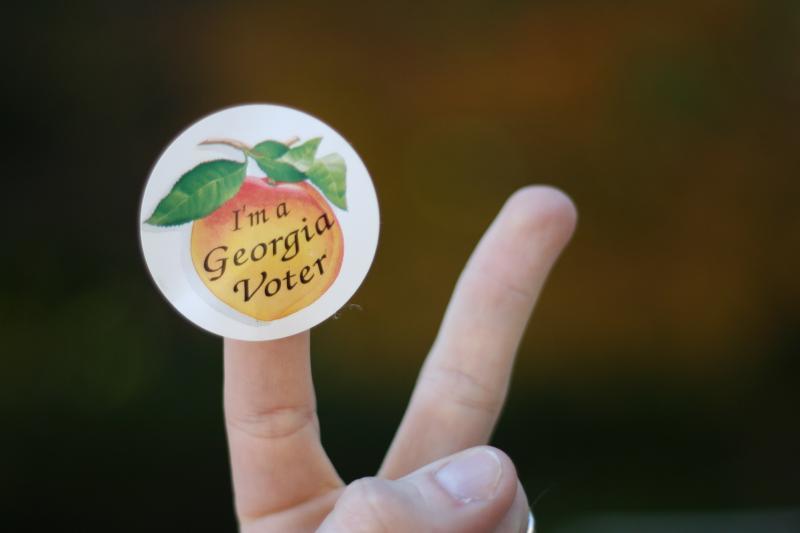Section Branding
Header Content
Breaking Down The 1.1 Million Votes Already Cast In Georgia’s June 9 Primary
Primary Content
More than 1.1 million Georgians have already participated in the June 9 primary, driven in part by a record-setting surge in votes by mail due to the coronavirus.
As of Thursday, June 4, more than 561,000 people had voted in the Republican general primary, 528,000 in the Democratic primary and 20,000 returned a nonpartisan ballot.
About three-quarters of the ballots received so far have been submitted by mail – more than 20 times the 37,000 absentee ballots mailed in the 2016 general primary.
Since the presidential primary and general primary were delayed because of the pandemic, more than 1.6 million Georgians requested an absentee ballot to avoid showing up at the polls and risking exposure to COVID-19.
Republican Secretary of State Brad Raffensperger mailed absentee applications to 6.9 million active voters in April and has urged voters to take advantage of mail-in ballots this election. Last month, the State Election Board passed an emergency rule allowing counties to install secure drop boxes to give voters another option to return absentee ballots.
Data from the secretary of state’s absentee voter file shows which counties and precincts have turned out the most and the least during early voting and that could paint a picture of where longer lines could be on Tuesday, June 9, the day of the election.
IN-DEPTH: More Voters, Fewer Polls Means Long Lines Likely For Georgia Primary
Only five of Georgia’s 159 counties have seen more in-person votes than absentee votes: Pickens, Long, Clinch, Atkinson and Echols. In contrast, Talbot County has logged roughly 10 times as many absentee votes as those in-person, 1,157 to 110.
In Cobb County, nearly 90% of the early votes cast have been by mail.
According to the absentee data, more than 40% of the nearly 2,000 active voters in Glascock County have already voted, the highest percentage in the state.
Second-highest is Towns County, on the Tennessee border, where officials recently voted to close two of the three election day polling places because of COVID-19 and a shortage of poll workers. Nearly a third of its roughly 10,000 active voters have voted early.
Nearly 30% of Rabun County’s active voter population has voted so far, three-quarters of them by mail.
The two lowest-turnout counties have been hit especially hard by the coronavirus in recent months. Dougherty County is home to nearly 63,000 active voters and was the epicenter of a devastating coronavirus outbreak in the surrounding southwest Georgia region. Only 4,400 registered Dougherty voters have cast ballots.
Fewer than 10% of Fulton County’s active voters have voted early, and the county has been plagued by problems and delays with the primary.
As absentee ballot requests began pouring in through postal mail and email, the county’s election office had to be closed for several days for cleaning after an elections worker died from COVID-19.
The State Election Board is investigating reports that Fulton also never processed an unknown number of applications emailed into the office, as voters complained of never receiving a ballot weeks after submitting a request.
This election is unprecedented in many ways, as counties have scrambled to process a record number of absentee ballots, provide protective gear for poll workers, and deal with last-minute changes to polling locations. Not to mention the first statewide test of a $104 million touchscreen voting system.
These issues are compounded by increases in the registered voter population and fewer places to vote, even before coronavirus.
Dozens of polling places across Georgia serve more than 10,000 voters. Some cover entire counties like Butts, Lumpkin, Rabun and Stephens.
Other large precincts are in fast-growing metro counties, including five mega-precincts in Forsyth County. Officials there have added five polling places in the past year to accommodate a roughly 60% spike in registered voters over the past decade.
Fulton County
On the higher end of the spectrum, there are now polling places that serve more than 10,000 of voters because multiple precincts are set to vote there. In Fulton County, which has more than 760,000 active voters, more than 40 locations have changed or closed in recent months.
Park Tavern, a restaurant and event space in Piedmont Park, is preparing to serve a record number of voters — roughly 16,000 people — after elections officials combined five precincts from two other polling places that subsequently became unavailable.
In the 2016 primary, those five precincts collectively had a 7% turnout. This year, turnout is already at 10%, and 80% of those ballots have been cast by mail.
Due to social distancing requirements, voters could well see long lines and limited parking availability at this majority-white voting location.
Like Park Tavern, the Cathedral of Saint Philip in Buckhead will serve as the polling place for four precincts, totalling more than 13,000 voters. Turnout for these precincts increased from 8% in 2016 to 11% now. A majority of those voters submitted ballots by mail.
Another polling place, Johns Creek Environmental Campus in Alpharetta, is set to serve nearly 12,000 voters. Fulton County plans to have 10 voting machines and six poll workers at this location. Combined early turnout for the precincts assigned to vote there is almost 13%.
Despite several dropboxes and eight locations open for early voting, voters in Fulton County have already experienced long lines. Voters at College Park Library reportedly waited upwards of five hours on the final day of early voting. Voters at Garden Hills Elementary School also saw delays.
Gwinnett County
Two years ago, Gwinnett county made headlines for long lines at the polls, and a federal judge ordered three locations to stay open late to allow every vote to be cast.
That majority-black precinct, Annistown Elementary near Snellville, has grown nearly 50% since 2012, and currently has about 4,000 active registered voters assigned to cast ballots there.
This year, Gwinnett faces the potential for more delays after adding 170,000 new active registered voters since 2012 without adding a single polling place.
Seven of Gwinnett County’s 156 precincts have more than 6,000 active registered voters, and all but one of them have polls in majority non-white areas of Dacula, Duluth, Lawrenceville and Loganville. Turnout for the county is running about 12%.
The county’s three largest precincts, each around 7,000 active registered voters, have seen lower turnout between 7% to 10% turnout so far.
Cobb County
Though Cobb County’s voter rolls grew by more than 100,000 since 2012, there are fewer polling places to accommodate the increasingly-diverse voter population.
The share of white voters decreased from 64% in 2012 to 55% today, as the share of black votes increased from 25% to 42%.
The elimination of six polling places combined with coronavirus safety measures could lead to long lines for voters in Cobb’s largest precincts.
The largest precinct in Cobb County is MR3A, just west of Marietta. Of its 6,300 active voters, about half are white and 34% are black.
More than 1,000 voters in this precinct have participated in the June 9 primary — nearly three-fourths of them by mail. Sixty-two percent of votes cast were Democratic.
The second-largest precinct, KE3A, is located in Kennesaw, just west of Interstate 75. The majority-nonwhite precinct now has five times the number of registered voters it did in 2012, and the number of black registered voters skyrocketed by 741%, outpacing all other demographics.
Only 11% of the 6,200 active voters have cast a ballot as of Thursday evening.
The third largest precinct, VG02 which covers part of Vinings, has about 6,150 active registered voters.
Though the registered voter population has not grown much in this majority white precinct, voter turnout nearly doubled since the 2016 primary, when only 8% of voters cast ballots. This year, more than 15% of voters have already voted, the vast majority by mail.
Nearly 800,000 absentee ballots that were mailed out to voters have not yet been returned and processed, which could cut down on the number of voters at the polls Tuesday –– or add to it, if people change their minds and wish to vote in person.
Several counties have secure 24/7 drop boxes set up for voters to return their ballot safely, and all absentee ballots must be received by your local elections office by 7 p.m. when polls close Tuesday.





